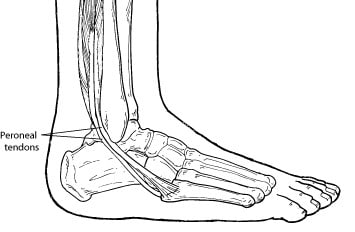Managing injuries of this type can make an enormous difference to your recovery time and to your mobility and fitness following the injury, and understanding how these injuries occur can be very useful.
How Do I Know if I Have a Peroneal Tendon Injury?
 Any unexplained or sudden pain in your feet should be checked out by a doctor, and it is a good idea to visit your GP quickly in case your injury worsens. An examination of the foot, and an x-ray if necessary, will be carried out to discover the extent of your injury.
Any unexplained or sudden pain in your feet should be checked out by a doctor, and it is a good idea to visit your GP quickly in case your injury worsens. An examination of the foot, and an x-ray if necessary, will be carried out to discover the extent of your injury.
Peroneal tendon injuries can be acute, when they occur suddenly, or chronic, when they develop over a period of time. People who have higher arches are at risk of developing peroneal tendon injuries, and they are most common amongst those who take part in sports that involve repetitive ankle movements.
How Are Peroneal Tendon Injuries Treated?
There are different types of peroneal tendon injuries, and you may be given different advice and treatment if you have a specific pain or pattern of discomfort. Treatment options include:
1. Immobilization. Using a cast or a splint to keep the foot and ankle in one position is often necessary to allow the injury to heal and to prevent movement, which could worsen it.
2. Physical therapy. Ultrasound therapy, or the use of heat or ice to reduce swelling and pain, may be used initially, and exercises are usually suggested to strengthen the muscles and increase the range of motion and balance.
3. Medications. Sometimes, your doctor may prescribe anti-inflammatory medications to help with swelling and ease the pain you are feeling.
4. Bracing. You may be advised to wear an ankle or foot brace for a period of time, or when you are undertaking activities that could cause the injury to worsen or recur.
5. Surgery. Occasionally, you might need surgery to repair one or both tendons, and the supporting structures of the foot. This will involve physical therapy to rehabilitate the area.
Prevent Foot Problems With Good Footwear
The best way to prevent foot problems and avoid unnecessary pain is to ensure that you always wear well-fitted shoes that are supportive and comfortable, and suited to their use. Good training shoes for exercise are particularly important, and you should always ensure that professionals, who can advise you on any underlying foot problems, fit your shoes. If your gait isn’t within the normal range, then you may also need additional support for your feet.
Foot Solutions can help you to find the perfect shoes for your feet, as well as stocking many helpful products such as insoles and arch supports to keep your feet in good alignment & keep you feeling great.























